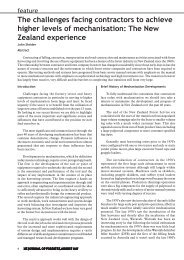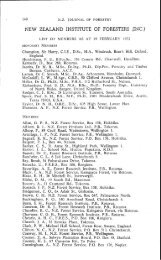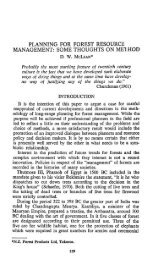JAS log volume estimates of New Zealand radiata pine and Douglas ...
JAS log volume estimates of New Zealand radiata pine and Douglas ...
JAS log volume estimates of New Zealand radiata pine and Douglas ...
You also want an ePaper? Increase the reach of your titles
YUMPU automatically turns print PDFs into web optimized ePapers that Google loves.
Table 5c<br />
Taper (cmlm)<br />
0.4 - 0.79<br />
0.8 - 1.19<br />
1.2 - 1.59<br />
1.6 - 1.99<br />
small-end diamel<br />
20-30<br />
1.119<br />
1.033<br />
0.942<br />
0.867<br />
r class (cm)<br />
30-40<br />
1.127<br />
1 .O68<br />
1.022<br />
0.959<br />
2.0 - 2.39 0.566 0.799 0.901<br />
Table 5c Conversion from <strong>JAS</strong> to cubic metres radfata <strong>pine</strong> 9.0 -<br />
11.9 m<br />
Table 5d Conversion from <strong>JAS</strong> to cubic metres <strong>Douglas</strong>-& 3.0 -<br />
5.9 m<br />
Table 5e<br />
10-20<br />
1.115<br />
0.942<br />
0.795<br />
0.662<br />
umes <strong>and</strong> actual <strong>volume</strong>s for each small-end diameter, length <strong>and</strong><br />
taper class. Each conversion factor is the <strong>JAS</strong> <strong>volume</strong> divided by<br />
the actual <strong>volume</strong>. Tables 5a to f give conversions from cubic<br />
metres to <strong>JAS</strong>, which is the amount <strong>of</strong> <strong>JAS</strong> per cubic metre. To<br />
convert from <strong>JAS</strong> units to m3, the <strong>JAS</strong> <strong>volume</strong> is divided by the<br />
table value.<br />
The precision <strong>of</strong> each table value (Table 5a to f) was calculated.<br />
The probable limit <strong>of</strong> error for each value was generally<br />
within 0.5% for <strong>radiata</strong> <strong>pine</strong> <strong>and</strong> within 1.3% for <strong>Douglas</strong>-fir.<br />
However, where there are relatively few observations such as the<br />
10-20 cm sed in the 2.0-2.39 cmlm taper class the PLE averaged<br />
9% <strong>and</strong> 16% for <strong>radiata</strong> <strong>pine</strong> <strong>and</strong> <strong>Douglas</strong>-fir respectively. The<br />
probable limit <strong>of</strong> error (PLE) is the confidence interval (approximately<br />
2* st<strong>and</strong>ard error) <strong>of</strong> each conversion expressed as a percentage<br />
<strong>of</strong> the respective average conversion value.<br />
Discussion<br />
Bias in <strong>JAS</strong> <strong>volume</strong> (Figs 4a to f) <strong>and</strong> implied in the conversion<br />
values (Tables 5a to f) are from sed which is based on girth measurement<br />
Any overestimate in diameter due to the use <strong>of</strong> the girth<br />
tape is common to sed <strong>and</strong> <strong>volume</strong> <strong>and</strong> therefore has no effect on<br />
the result. However, the <strong>JAS</strong> conventions <strong>of</strong> sed always being<br />
rounded down, <strong>and</strong> sed being based on the shortest axis, do have<br />
a direct bearing on <strong>volume</strong>.<br />
For most <strong>of</strong> the diameter range (14 cm upwards) the <strong>JAS</strong> sed<br />
is the diameter in even centimetres. For example, a diameter 25.9<br />
cm is recorded as 24 cm in <strong>JAS</strong>. In theory this rounded-down<br />
<strong>JAS</strong> should be 1.0 cm lower than the actual sed In practice, sample<br />
data show the rounded-down <strong>JAS</strong> about 0.9 cm lower than<br />
the actual sed. This is because where the diameter is close to the<br />
even centimetre, the scaler identifies a 2 mm division more easily<br />
than a single millimetre.<br />
In this study the effective <strong>JAS</strong> diameter is based on the girth<br />
tape <strong>and</strong> therefore approximates an average <strong>of</strong> shortest <strong>and</strong><br />
longest axis <strong>of</strong> the small-end section. The difference between<br />
using <strong>JAS</strong> based on average sed <strong>and</strong> "shortest" sed was examined<br />
on an external data set <strong>of</strong> 2253 export <strong>log</strong>s measured<br />
throughout <strong>New</strong> <strong>Zeal<strong>and</strong></strong>.<br />
Table 6 below shows the diameter <strong>and</strong> <strong>volume</strong> differences due<br />
to using a short axis instead <strong>of</strong> an average diameter.<br />
Species<br />
I<br />
small-end dia meter class in centinetres<br />
20.0 - 29.9 30.0 - 39.9<br />
I<br />
0.69<br />
(2.7%)<br />
0.49<br />
(1.9%)<br />
0.028<br />
(5.2%)<br />
0.026<br />
0.99<br />
(2.9%)<br />
0.65<br />
(1.9%)<br />
0.OM)<br />
(6.3%)<br />
0.046<br />
Table 5e Conversion from <strong>JAS</strong> to cubic metres <strong>Douglas</strong>-& 6.0 -<br />
8.9 m<br />
Vol reduction (m3)<br />
Table Sf<br />
Table Sf Conversion from <strong>JAS</strong> to cubic metres <strong>Douglas</strong>-& 9.0 -<br />
11.9 m<br />
l4.h%)<br />
(4.8%)<br />
Table 6 Diameter <strong>and</strong> <strong>volume</strong> reductions due to use <strong>of</strong> short ads on<br />
end section<br />
Values in brackets give <strong>volume</strong> reduction as a percentage <strong>of</strong><br />
average <strong>volume</strong>.<br />
The above reductions are independent <strong>of</strong> taper <strong>and</strong> for practical<br />
purposes do not affect length. Small-end diameter <strong>and</strong><br />
species do have an effect on the magnitude <strong>of</strong> the reduction. Volumes<br />
used in compiling the graphs (Fig. 4) <strong>and</strong> conversion values<br />
(Tab. 5) have been altered by the reductions in Table 6.<br />
<strong>Douglas</strong>-fir is more cylindrical <strong>and</strong> less tapered (for same sed <strong>and</strong><br />
length) than <strong>radiata</strong> <strong>pine</strong>. Thus <strong>Douglas</strong>-fir has higher <strong>JAS</strong> to<br />
cubic metre conversions than <strong>radiata</strong> <strong>pine</strong>.<br />
N.Z. FORESTRY MAY 1996 35





